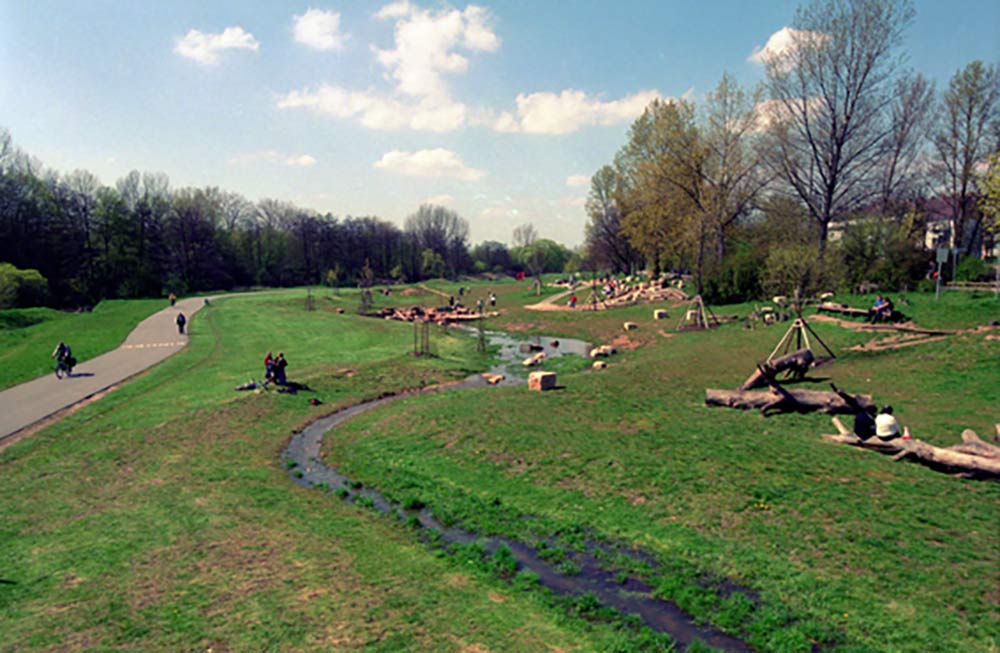
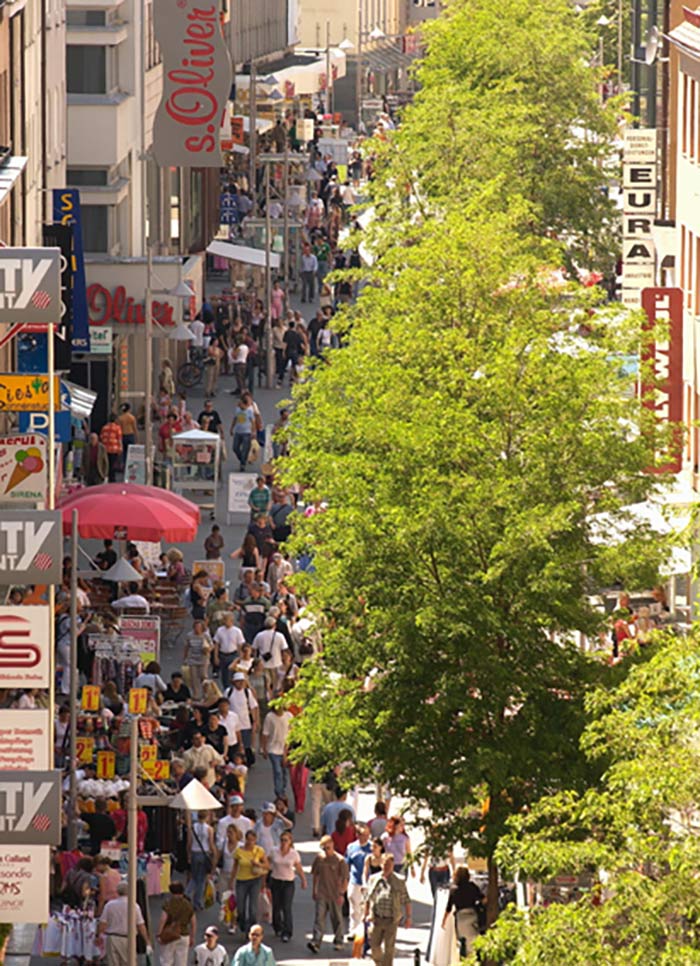
The city’s many parks, the wide river banks of the River Pegnitz in the middle of Nuremberg, the lakes, as well as the Main-Danube-Canal offer countless leisure opportunities. Whether on inline skates or in a rowing boat, as an individual or as a member of a group – you will not get bored, even on “event-free” days.
The city’s many leisure facilities for children and teenagers, its restaurants, bars, discos and clubs, and also its meeting points for senior citizens with their extensive programmes of events cater for the most varied interests. Film freaks can choose from a wide variety: the multiplex cinema Cinecitta with its IMAX-cinema and its 1000 square meters domed screen is a popular meeting point for Nuremberg’s young people. The municipal Filmhauskino cinema presents arthouse films. It is located in the Künstlerhaus K4, together with several other leisure and culture organisations.
Especially in the summer, Nuremberg’s citizens love to roam the attractive countryside around the city. Nuremberg’s extensive public transport system takes you to many attractive places in Franconia, even without a car. You could go for some baked carp in the Aischgrund.
Or walkers could quench their thirst in one of Franconia’s breweries – the area boasts the world’s highest density of breweries. Some of them are located in Romantic river valleys and right next to steep Jurassic rock formations. The “Franconian Lake District” is a paradise for water sports fans.
Nuremberg — more infos
E.g. Nuremberg — travel guide & visitor info with an overview, weather and best season, airport, map & more.
Or find all our Nuremberg articles by using the TAG Nuremberg or type into the search field: Nuremberg
Nuremberg Christmas Market
One of the most famous Christmas markets in the world: Nürnberg Christkindlmarkt
Nuremberg’s Annual Events and Festivals
Festivals and (culinary) specialties have a long tradition in and around Nuremberg. Every year during the asparagus season, gourmets may sample this delicious vegetable on the Asparagus Market.
The Altstadtfest, an annual late summer festival celebrated in the Old Town, excels by its culinary variety. Two million visitors from all over the world come to Nuremberg in December to visit the Christkindlesmarkt, Nuremberg’s famous Christmas market, considered by many to be the world’s most beautiful Christmas market.
Younger visitors will enjoy the Kinderweihnacht (Children’s Christmas Market) where historic steam-powered merry-go-rounds and other activities are waiting for them. The Sternenhaus (House of Stars) across the street offers an exciting entertainment program.
When Nuremberg becomes “Germany’s No 1 Christmas City”, this marks also the high season for one of its specialties: Lebkuchen (spicy gingerbread).
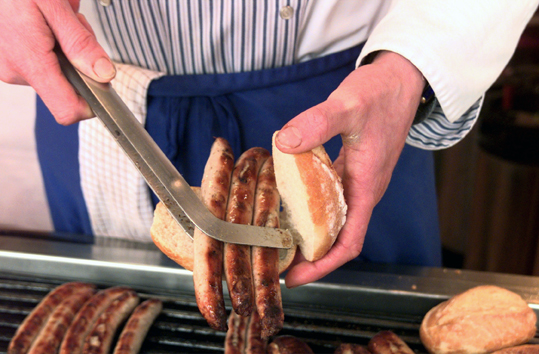
Nuremberg’s Bratwürste (fried sausages) are delicious all year round – whether as street food served in a roll (Drei im Weckla – Three in a Roll), or sampled in one of the historic Bratwurst restaurants in the Old Town or in one of the city’s many beautiful beer gardens.
Read also: German Food specialties
Read also: Nuremberg Roast Sausages / Three in a Roll
Rock am Ring and Rock am Park are 2 of the most important and biggest music festivals in Germany.
Albrecht Dürer’s House
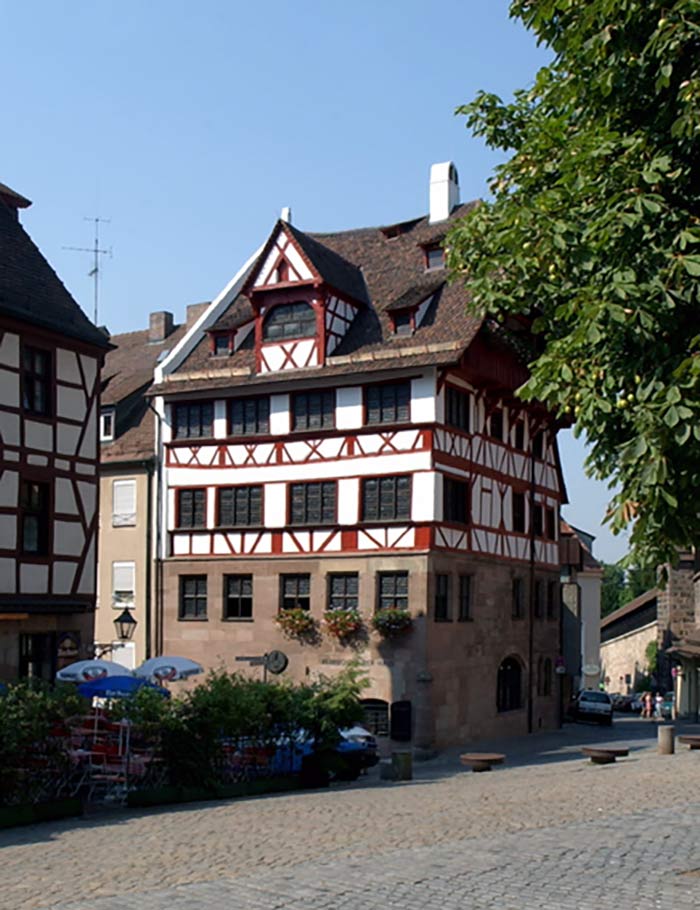
“Back to Dürer” – this is the motto of Albrecht Dürer’s House: presenting the living and working quarters of the great artist, Albrecht Dürer (1471-1528).
The museum shows all facets of Dürer and his work. In the screening room, the multivision show “Albertus Durer Noricus” allows a unique novel view of Dürer’s work.
After this introduction, a tour takes visitors through all four floors of the house which was Dürer’s residence between 1509 and 1528. A particular attraction: the large painting and printing workshop from Dürer’s time where artistic techniques are demonstrated.
By the way: the lady of the house will guide visitors through her home in person. Via a headset, “Agnes Dürer” provides information (in five languages – German, English, French, Italian and Japanese) and, especially for children, she talks about her daily worries and the ups and downs in this artistic household. Sometimes, on request, she even turns up in person for a guided tour (played by an actress) for adults or children.
Website: https://museums.nuernberg.de/duerer-house/
Frauenkirche (Our Lady’s Church)
Emperor Charles IV had the Church of Our Lady’s (Frauenkirche) built here between 1355 and 1358 on the site of the destroyed synagogue of the former Jewish quarter (pogrom in 1349).
It was the first Gothic hall church in Franconia, constructed as an Imperial court chapel with three aisles. Its builder was presumably Peter Parler, the master builder of the Prague St Vitus’ Cathedral. In 1361, on the occasion of the baptism of the heir to the throne, the Imperial Crown Jewels were displayed here for the first time. The “Männleinlaufen” (“Running Men” clockwork at noon), created in 1509 by Sebastian Lindenast and Georg Heuß, is reminiscent of the proclamation of the Golden Bull of 1356: seven electors pay homage to Emperor Charles IV sitting on the throne.
The main altar is the “Tucher Altar” which was the high altar in the Augustine Church up until 1487. The epitaphs, most of which are from the Dominican’s and the Augustine’s churches, include works by Adam Kraft (Peringsdörfer epitaph) and by Michael Wolgemut.In 1816, the Church of Our Lady’s was given to Nuremberg’s Catholic congregation.
Address:
Church of Our Lady, Hauptmarkt 14, 90408 Nuremberg
Handwerkerhof (Crafts Yard)
A Nuremberg sight with a very special ambience. Right in the middle of Nuremberg’s city, surrounded by the towers and walls of the medieval city fortification, the “Crafts Yard” (“Handwerkerhof”) invites Nuremberg’ guests on an exciting stroll. This “little town near the Königstor”, opposite the Main Railway Station offers traditional crafts and Franconian hospitality in a charming atmosphere. It is quite astonishing what you can discover in those little workshops, shops and lanes: craftsmen such as pewterers, bag-makers, glass engravers, potters, wax artists, gold and silversmiths, glass painters, gingerbread bakers and doll makers have set up their workshops and show their skills in pretty half-timbered houses.
Hospitality and cosy Franconian atmosphere can also be found in the Crafts Yard: the famous Nuremberg roast sausages and other savoury Franconian specialities are best washed down with a tankard of fresh Nuremberg beer or a glass of Franconian wine.
Address:
Am Königstor, 90402 Nuremberg
Kaiserburg (Imperial Castle)
The Imperial Castle, symbol of Nuremberg, rises high above the city. The castle, where between 1050 and 1571 all Emperors of the Holy Roman Empire of the German Nation were in residence at least for some time, is one of the most important imperial palaces of the Middle Ages.
The Palas (main building) with its sumptuously furnished Emperor’s rooms, the Roman double chapel, the deep well, and the Sinwell Tower, as well as a comprehensive collection of weapons and utensils can be visited today.
Website: https://www.schloesser.bayern.de/englisch/palace/objects/nbg_burg.htm
Germanisches Nationalmuseum
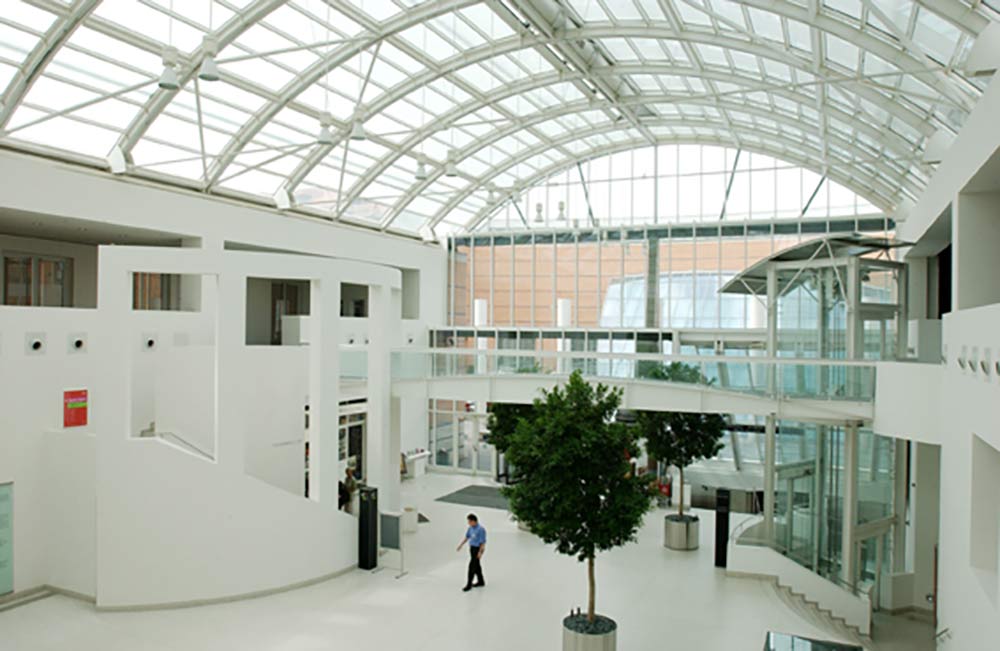
The Germanische Nationalmuseum (GNM) has existed since 1852. It was founded by Hans Freiherr von und zu Aufseß who intended to collect and display exhibits relating to German culture and history.
Today, the museum’s collection comprises over 1.2 million objects, making it Germany’s largest museum of cultural history, as well as the National Museum of the Federal Republic.
A Carthusian monastery with cloister, church and monks’ dwellings forms the architectural core of today’s museum. The external aspect is dominated by buildings designed by architect, Sep Ruf, in the 1950s and 1960s, as well as by the museum forum created in 1993, and the “Way of Human Rights” designed by artist, Dani Karavan.
The Germanisches Nationalmuseum is one of Europe’s largest and greatest museums. Its incomparable stores of exceptional art and artisanship afford a panoramic overview of the cultural history of German-speaking central Europe. Experience for yourself, in the former imperial city of Nuremberg, the remarkable range and diversity of German art and culture! Enjoy a fascinating voyage through history, from hand axes of Neolithic times to the arts and culture of the present day.
Website: https://www.gnm.de/
DB Museum (German Railway Museum)
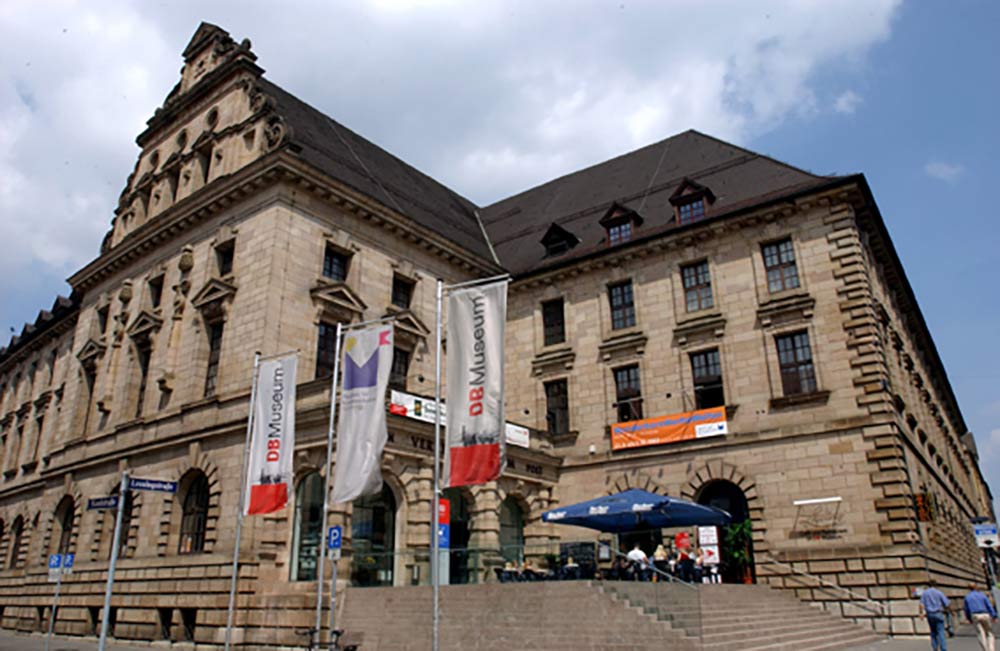
The DB Museum, opened in 1899 as Royal Bavarian Railway Museum, is Germany’s oldest railway museum. Today, as museum of the Deutsche Bahn AG, together with the Museum of Communication, it forms the Nuremberg Traffic Museum. Exhibits include about 40 historic rail vehicles, among them the legendary “Adler” (Eagle) locomotive.
In addition to numerous special exhibitions and events, the museum’s main attraction is the “Experience Area” of 1,000 square metres.
Website: https://www.dbmuseum.de/museum_en
Dokumentationszentrum Reichsparteitagsgelände (Documentation Centre Nazi Party Rally Grounds)
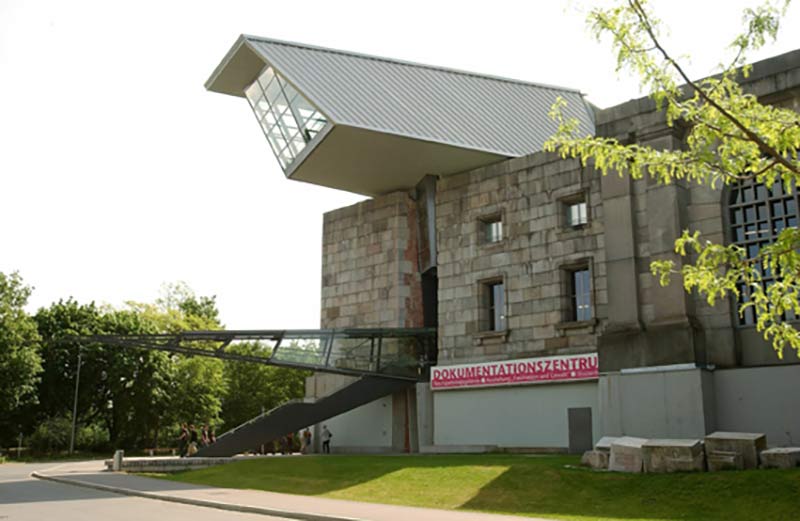
In 1933, the National Socialists decided that Nuremberg was to be the “City of the Party Rallies”. They created a link between the Nazi movement and Nuremberg’s glorious past as Free City of the Empire and venue for the imperial diets in the middle ages. This is why they staged the annual NSDAP party rallies here ever year in September, up until 1938. Designed by Albert Speer, in the city’s southern districts, the “Party Rally Grounds” were erected as a huge parade ground on an area of 24.5 hectares. Zeppelin Field and Zeppelin Grandstand, the unfinished Congress Hall and a large excavation intended for the planned German Stadium are what remains in the city, as the monstrous stone legacy left behind by this regime of terror.
The Documentation Centre Party Rally Grounds, opened in 2001, is located in the north wing of the unfinished shell of the Congress Hall. On 1,300 square metres, the permanent exhibition “Fascination and Terror” deals with the causes, contexts and consequences of the National Socialist rule of terror. The focus of the 19 exhibition areas is on topics which relate directly to Nuremberg, arranged in chronological order. Topics include the history of the party rallies, the buildings on the Party Rally Grounds, the “Nuremberg Racial Laws” of 1935, the “Nuremberg Trial” of the main war criminals responsible for Nazi crimes in 1945 and the twelve follow-up trials, as well as the difficult process of dealing with the architectural legacy left behind after 1945.
In addition to the permanent exhibition, there is a Study Forum which is of central importance to the work of the Documentation Centre Party Rally Grounds. In special seminar rooms located on the roof of the Congress Hall, Nuremberg Municipal Museums in co-operation with several partners, offer an in-depth educational programme for school classes, youth groups and groups of adults. The programmes on offer range from 45 minutes of discussion after visiting the exhibition to full seminar days.
Website: https://museums.nuernberg.de/documentation-center/
Cultural Highlights
A Wide Range of Museums, Music Festivals and of Cultural Events characterise Today’s Dürer City
Thanks to the good example of the city’s greatest son, Albrecht Dürer (1471-1528), genius of innovation, Nuremberg does not find it hard to reconcile the extremes of tradition and modernity. So it’s not a great surprise that visitors following the Albrecht Dürer Way are guided through the city using state-of-the-art audiovisual technology, and that people are again and again reminded of the relevance of Dürer’s genius and brilliant works of art with spectacular art events.
Just like Dürer’s paintings in the Germanische Nationalmuseum, the largest museum of German arts and culture, many other works of art can be admired in the city, for example the Englische Gruß (Annunciation) by Veit Stoß, in St. Lawrence’s Church, or the Way of the Cross created by stone sculptor Adam Kraft in the St. Johannis city district, all testifying to the city’s great history.
The city’s museums truly bring history to life – with lively guided tours and museum theatre performances, illustrating Dürer’s life and work, but also every-day-life in a Patrician household.
Nuremberg’s traditions as a toy city and as an industrial location are literally made tangible in the Toy Museum and in the Museum of Industrial Culture. Present-day art and design is displayed in the New Museum, and the Kunsthalle presents a forum for contemporary art.
Those interested in the very beginnings of communication as well as railway fans will get their money’s worth in the museums of communication and transport. Those institutions – and many more – are part of the Blue Night, a night of culture and museums with a difference which takes place every year in May and which is a great popular success.
Nuremberg State Theatre with its opera, theatre and ballet performances is the focus of the city’s theatrical life, which is further enriched by various free theatre groups.
Among them are the puppet players from all over the world meeting up at the International Puppet Theatre Festival in Nuremberg. A cultural centre for children (including a museum and theatre), several other theatres, and a wide network of activities for younger audiences make Nuremberg a champion of children’s culture. Eleven “Cultural Corner Shops” offering cultural activities in various city districts are exemplary for all of Germany.
Nuremberg’s musical life has much to offer, spanning the annual International Nuremberg Organ Week ION, Europe’s largest and oldest festival for sacred music; to “Rock in the Park” and the world music festival Bardentreffen.
The Bardentreffen, which is completely free of charge, takes place on a weekend and attracts over 200,000 music fans every year.
The two summer concerts Classic Open Air presented by the Nuremberg Philharmonic and Symphony Orchestras lure more than 100,000 music fans to the Luitpold Grove for a picnic and classical music and are the biggest events of their kind in Europe.

